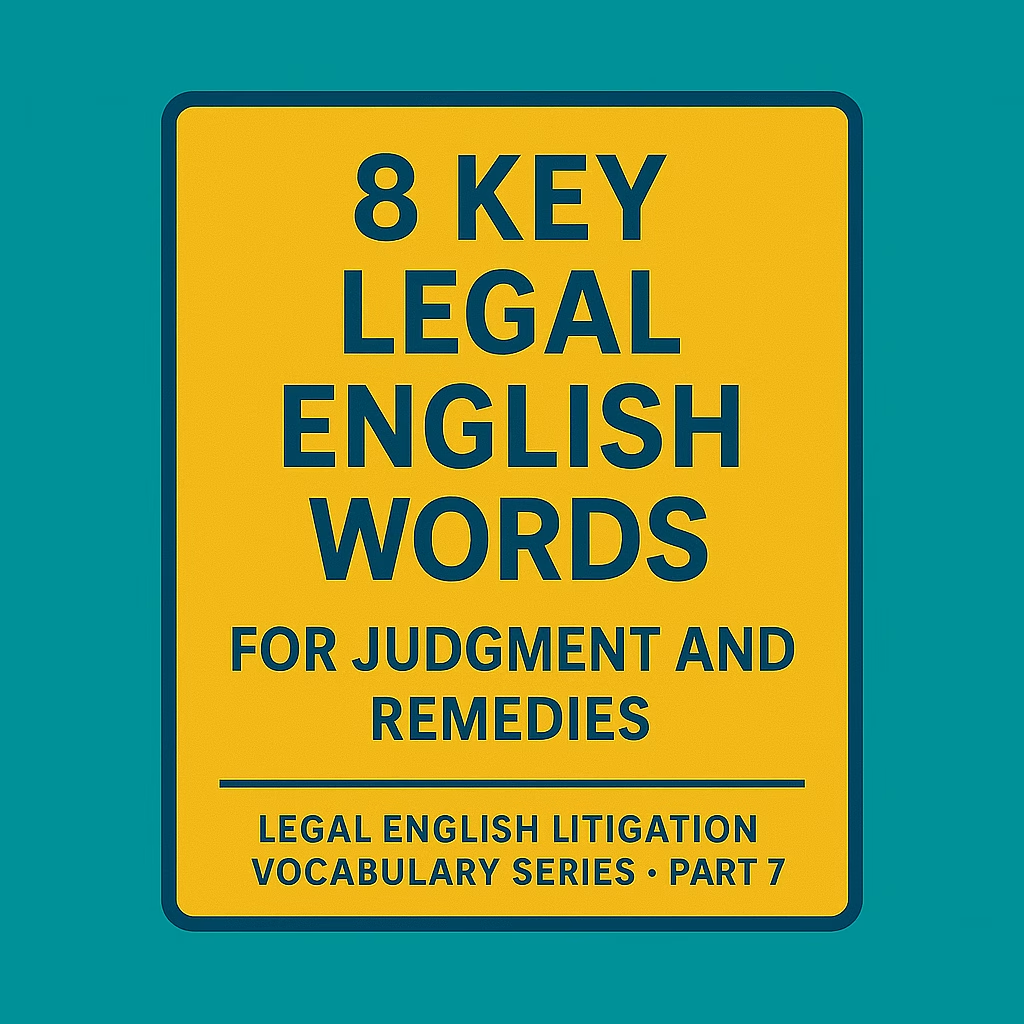
Ready to Go Deeper?
At LegalEnglish4Lawyers.com, we don’t just define legal terms — we explore them through real documents, client scenarios, and clause-by-clause analysis.
Click here to see a quick view of all posts.
-
Appeals and Enforcement – 8 Key Legal English Vocabulary Words – Litigation Vocabulary Series – Part 8

Legal English Litigation Vocabulary Series – Part 8 Introduction To Legal English for Appeals and Enforcement.
The litigation process doesn’t always end with judgment. For many clients, the most critical work begins with an appeal or the challenge of enforcing a judgment. This final stage requires a new set of Legal English skills—focused on persuasive writing, procedural accuracy, and strategic enforcement tools. In Part 8 of our Litigation Vocabulary Series, we cover essential vocabulary for lawyers handling appellate litigation or enforcing court-ordered outcomes across jurisdictions.
8 Key Vocabulary Words for Appeals and Enforcemnt
1. Notice of Appeal
Definition:
A formal filing that initiates an appeal by notifying the court and opposing party of the intent to challenge the judgment.
Example:
The defendant filed a notice of appeal within the 30-day statutory deadline.
Legal Context:
This is the first procedural step in appellate litigation. The notice must be filed timely and correctly, or the right to appeal may be lost. It begins the process of transferring the case to a higher court for review.
2. Appellate Brief
Definition:
A written argument submitted to an appellate court, outlining the legal reasons for reversing or affirming the lower court’s decision.
Example:
The appellant’s brief argued that the trial court abused its discretion by excluding key evidence.
Legal Context:
Appellate briefs must cite legal precedent and explain how the trial court erred. They are central to the appellate process and often more influential than oral argument. Crafting persuasive, precise legal English in briefs is a critical skill.
- Appellant: The party appealing the lower court’s decision.
- Abuse of discretion: A standard of review alleging the trial court made a clearly unreasonable decision.
3. Record on Appeal
Definition:
The complete set of documents, pleadings, evidence, and transcripts from the trial court submitted for appellate review.
Example:
The record on appeal included all pre-trial motions and the trial transcript.
Legal Context:
The appellate court reviews only what is in the record; no new evidence may be introduced. Ensuring the completeness and clarity of this record is vital to appellate success.
4. Remand
Definition:
An appellate court’s order sending the case back to the trial court for further proceedings.
Example:
The appellate court reversed the judgment and remanded the case for a new trial.
Legal Context:
A remand may involve retrial, reconsideration, or other corrective actions. Lawyers must clearly understand and explain the appellate court’s instructions to proceed properly in the lower court.
5. Enforcement of Judgment
Definition:
The legal process of compelling the losing party to comply with the court’s final order—usually by paying damages or performing a specific act.
Example:
Plaintiff initiated enforcement proceedings after the defendant failed to pay the awarded damages.
Legal Context:
Enforcement mechanisms vary by jurisdiction and may include writs of execution, garnishment, or property liens. International lawyers must be familiar with both local and cross-border enforcement procedures.
- Garnishment: Legal seizure of wages or bank funds to satisfy a judgment.
- Lien: A legal claim on property to secure debt repayment.
6. Stay of Execution
Definition:
A court order temporarily suspending the enforcement of a judgment.
Example:
The trial court granted a stay of execution pending appeal.
Legal Context:
Stays are often granted to prevent irreparable harm while the appellate court considers the case. A bond may be required to protect the winning party during the delay.
- Bond: A security deposit guaranteeing payment if the appeal fails.
7. Writ of Certiorari
Definition:
An order from a higher court (typically a supreme court) agreeing to review a lower court’s decision.
Example:
The U.S. Supreme Court denied the petition for writ of certiorari, leaving the appellate ruling intact.
Legal Context:
This term often appears in high-level appellate work. It’s a discretionary tool—most petitions are denied—so the legal writing must be exceptionally persuasive.
8. Res Judicata
Definition:
A legal doctrine that prevents re-litigation of claims or issues that have already been finally decided.
Example:
The defendant moved to dismiss on grounds of res judicata, citing a previous judgment on the same facts.
Legal Context:
This principle ensures finality and judicial efficiency. Lawyers must understand when res judicata applies to avoid wasting resources or inadvertently forfeiting claims.
Conclusion
The appellate and enforcement stages require precision, strategy, and mastery of advanced Legal English. Whether drafting an appellate brief or enforcing a cross-border judgment, international lawyers must navigate complex language with clarity and confidence. Understanding the terms above will help ensure that your client’s victory—or appeal—is executed successfully.
For additional information see the following:
Appeals – U.S. Courts
Garnishment – Cornell LIITry Our Online Legal English Tutoring for Lawyers and Law Students
Clear, confident communication is essential for every lawyer. Whether you’re working on conversations, meetings, or documents, strong Legal English helps you succeed. Book a free coaching session and start building skills you can use in any area of legal practice.
Disclaimer
DISCLAIMER: The content provided herein is only for discussion purposes and may contain errors. The reader is responsible to confirm the accuracy of the information provided. The content does not constitute legal or professional advice. We disclaim any liability for any loss or damage incurred directly or indirectly from the use of this information.
-
Judgment and Remedies: 8 Key Legal English Words – Legal English Litigation Vocabulary Series – Part 7

Introduction To Judgment & Remedies.
When a trial concludes, the court enters its decision—and the consequences become real. Whether seeking financial compensation, injunctive relief, or a final declaration of rights, attorneys must be fluent in the specialized Legal English used to discuss judgment and remedies. This post—Part 7 in our 8-part Litigation Vocabulary Series—offers essential legal vocabulary to help international lawyers confidently navigate post-verdict proceedings and enforce outcomes across jurisdictions.
8 Key Words for Judgments and Remedies
1. Verdict
Definition:
The final decision by a jury (or a judge in a bench trial) on the issues presented during trial.
Example:
The jury returned a verdict in favor of the plaintiff, awarding $500,000 in damages.
Legal Context:
The verdict may be general (a simple decision for one party) or special (answering specific factual questions). It forms the basis for the court’s judgment and must be consistent with the instructions and law.
- General verdict: A blanket decision on liability and damages.
- Special verdict: A decision that breaks down findings on each legal element.
2. Judgment
Definition:
The official decision of the court that resolves the legal dispute and concludes the case.
Example:
The court entered judgment in favor of the defendant and dismissed the case with prejudice.
Legal Context:
Judgment may include monetary awards, declaratory relief, or injunctive orders. It may be final or interlocutory (temporary). Lawyers may also move for post-judgment relief to modify, enforce, or appeal the judgment.
- With prejudice: The case is permanently dismissed and cannot be refiled.
- Interlocutory judgment: A ruling on part of the case that does not resolve all issues.
3. Compensatory Damages
Definition:
Monetary compensation awarded to make the injured party whole.
Example:
The court awarded $250,000 in compensatory damages for lost wages and medical expenses.
Legal Context:
These damages aim to restore the plaintiff to the position they were in before the harm occurred. Common categories include economic (like lost income) and non-economic (like pain and suffering) damages.
- Economic damages: Tangible, quantifiable losses.
- Non-economic damages: Intangible harms such as emotional distress.
4. Punitive Damages
Definition:
Damages awarded to punish the defendant for egregious conduct and deter future wrongdoing.
Example:
The jury awarded $1 million in punitive damages due to the defendant’s intentional fraud.
Legal Context:
Punitive damages are not tied to the plaintiff’s loss but instead focus on the defendant’s misconduct. They are awarded in addition to compensatory damages and are subject to constitutional limits in some jurisdictions.
5. Injunction
Definition:
A court order that requires a party to do or stop doing a specific act.
Example:
The court issued a permanent injunction barring the company from using the plaintiff’s trademark.
Legal Context:
Injunctions may be temporary, preliminary, or permanent. They are often used in intellectual property, employment, and commercial disputes. To obtain one, the party must demonstrate irreparable harm and lack of an adequate remedy at law.
- Irreparable harm: A type of injury that cannot be adequately compensated by money.
- Remedy at law: A legal (usually monetary) solution rather than equitable relief.
6. Declaratory Judgment
Definition:
A legal determination that resolves uncertainty by declaring the rights or obligations of parties.
Example:
The court entered a declaratory judgment affirming the plaintiff’s right to terminate the contract.
Legal Context:
Declaratory relief is often used preemptively to resolve disputes before they escalate. It provides clarity, especially in contract and insurance cases, without necessarily awarding damages.
7. Costs and Fees
Definition:
Court-ordered payment of litigation expenses and, in some cases, attorney’s fees.
Example:
The prevailing party moved for an award of costs and attorney’s fees under the contract’s fee-shifting clause.
Legal Context:
Typically, the prevailing party may recover costs such as filing fees, transcripts, and service fees. Attorney’s fees are only awarded when authorized by statute, contract, or specific court rules.
- Fee-shifting clause: A contract provision requiring the losing party to pay legal fees.
- Prevailing party: The party that achieves a favorable judgment.
8. Equitable Relief
Definition:
A remedy that involves non-monetary court action, such as injunctions, restitution, or specific performance.
Example:
The court granted equitable relief by ordering the return of property rather than monetary compensation.
Legal Context:
Equitable remedies are discretionary and based on fairness. They typically apply when legal (monetary) remedies are insufficient. Equitable principles—such as clean hands and balancing the equities—guide these decisions.
- Clean hands doctrine: A party seeking equity must be free of wrongdoing.
- Balancing the equities: The court considers fairness to both sides when granting relief.
Conclusion
Understanding the vocabulary of judgment and remedies is essential not just for winning a case—but for securing a result that actually serves your client’s interests. Whether negotiating a settlement, seeking injunctive relief, or filing a motion for attorney’s fees, mastery of this Legal English allows attorneys to act decisively and precisely in post-trial litigation.
For further information.
Judgment – Legal Information Institute
Injunction – U.S. Courts GlossaryBuild Your Legal English Skills with Confidence
Clear, confident communication is essential for every lawyer. Whether you’re working on conversations, meetings, or documents, strong Legal English helps you succeed. Book a free coaching session and start building skills you can use in any area of legal practice.
Disclaimer
DISCLAIMER: The content provided herein is only for discussion purposes and may contain errors. The reader is responsible to confirm the accuracy of the information provided. The content does not constitute legal or professional advice. We disclaim any liability for any loss or damage incurred directly or indirectly from the use of this information.
-
The Trial Stage Legal English Vocabulary – 8 Essential Litigation Vocabulary Terms- Part 6

Introduction To The Trial Stage.
The trial is the culmination of months—or years—of litigation strategy. At this stage, clarity in courtroom communication is paramount. Whether addressing the judge, persuading a jury, or objecting to testimony, precise use of Legal English vocabulary for trial can influence the outcome. This sixth entry in our Litigation Vocabulary Series provides essential trial vocabulary to help lawyers speak and act confidently in the courtroom.
Legal English Litigation Vocabulary: Trial Phase
1. Voir Dire
Definition:
The jury selection process, during which attorneys question potential jurors to assess their suitability.
Example:
During voir dire, defense counsel asked if any jurors had personal experience with medical malpractice claims.
Legal Context:
Voir dire helps attorneys identify potential biases in jurors. Each side may exercise peremptory challenges or request removal for cause. Mastery of voir dire language is key to shaping a favorable jury.
- Peremptory challenge: A limited right to dismiss a juror without giving a reason.
- Challenge for cause: Dismissing a juror due to a demonstrated inability to be impartial.
2. Burden of Proof
Definition:
The obligation of a party to prove its assertions at trial.
Example:
The plaintiff carries the burden of proof to establish the elements of negligence.
Legal Context:
The burden may be one of preponderance of the evidence (civil cases) or beyond a reasonable doubt (criminal cases). Misunderstanding or misusing this term can lead to flawed arguments or jury confusion.
- Preponderance of the evidence: More likely than not (over 50% probability).
- Beyond a reasonable doubt: The highest standard of proof, used in criminal trials.
3. Exhibit
Definition:
A document, photo, object, or record formally introduced as evidence during trial.
Example:
Exhibit 4 was a copy of the disputed lease agreement.
Legal Context:
Exhibits must be properly authenticated and may require a foundation before admission. Understanding the language around introducing exhibits helps lawyers follow rules and avoid objections.
- Authentication: Proving that evidence is genuine.
- Foundation: Preliminary evidence establishing that an exhibit is admissible.
4. Objection
Definition:
A formal protest made during trial to challenge improper questions or evidence.
Example:
Defense counsel raised an objection to hearsay testimony.
Legal Context:
Objections preserve the trial record and shape how evidence is presented. Common objections include relevance, hearsay, and leading the witness. Knowing when and how to object in precise legal English is vital.
- Hearsay: An out-of-court statement offered to prove the truth of the matter asserted.
- Leading: A question that suggests its own answer, typically disallowed during direct examination.
5. Cross-Examination
Definition:
Questioning a witness called by the opposing party, often to test credibility or reveal inconsistencies.
Example:
On cross-examination, the witness admitted she had changed her statement.
Legal Context:
Cross-examination requires agility in language and strategy. Lawyers must phrase questions clearly and maintain control of the narrative. Missteps can allow witnesses to reinforce the opposing side’s case.
6. Direct Examination
Definition:
The initial questioning of a party’s own witness during trial.
Example:
Counsel used direct examination to establish the sequence of events from the client’s perspective.
Legal Context:
Direct examination is about storytelling through witness testimony. Lawyers must avoid leading questions and instead allow the witness to testify freely. Strong command of transitional and clarifying phrases is key.
7. Jury Instructions
Definition:
Legal guidelines provided by the judge to the jury before deliberations begin.
Example:
The court issued jury instructions explaining the burden of proof in a negligence claim.
Legal Context:
Jury instructions frame how jurors evaluate evidence and apply the law. Attorneys may submit proposed instructions or object to misleading language. Understanding the format and tone of instructions is crucial for advocacy.
8. Verdict
Definition:
The formal decision made by a jury or judge on the issues presented at trial.
Example:
The jury returned a verdict in favor of the defendant after three hours of deliberation.
Legal Context:
The verdict may be general (deciding who wins) or special (addressing each element or question separately). Lawyers must understand and explain verdict forms clearly, especially in multi-claim cases.
- General verdict: A simple decision in favor of one party.
- Special verdict: A breakdown of findings on individual legal issues or claims.
Conclusion
At trial, language becomes performance. Each word must be chosen not just for legal accuracy, but for persuasive clarity. Whether you’re drafting jury instructions or objecting mid-testimony, advanced fluency in Legal English for trial empowers attorneys to advocate effectively, avoid errors, and present a credible case before judge or jury.
Build Your Legal English Skills with Confidence
Clear, confident communication is essential for every lawyer. Whether you’re working on conversations, meetings, or documents, strong Legal English helps you succeed. Book a free Legal English tutoring session and start building skills you can use in any area of legal practice.
Disclaimer
DISCLAIMER: The content provided herein is only for discussion purposes and may contain errors. The reader is responsible to confirm the accuracy of the information provided. The content does not constitute legal or professional advice. We disclaim any liability for any loss or damage incurred directly or indirectly from the use of this information.

